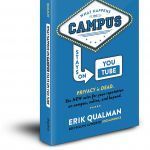Erik Qualman's Blog, page 548
April 24, 2015
3 Ways Your Small Business Can Use Social Networking Sites to Increase Sales

Originally designed for the purpose of enhancing personal networking and conversation among peers, social media has evolved into one of the most powerful tools a small business can have at its disposal. In addition to spreading brand awareness, a savvy company can actually monetize its efforts through the use of several innovative strategies.
Here are three of the best options.
2. Invest in paid advertisements
Paid advertising is probably one of the best ways to monetize your social media efforts. You should approach this strategy with caution, though.
If you don’t have a proper understanding of how PPC advertising works, some advance study is warranted if you hope to avoid tally up an expensive bill. If you’re already familiar with PPC advertising, such as AdWords, on the other hand, the learning curve will be fairly gentle.
By setting your budget, optimizing your posts, and implementing a savvy bidding strategy, you can expect to boost incoming traffic fairly quickly. The key is to focus on your target audience.
Facebook is the ideal social media platform to start with, because the site and its managers know so much about its users. Facebook allows you to implement sophisticated targeting strategies.
If you already have buyer personas, you shouldn’t have any trouble accounting for those within the Facebook Ad platform. You can control everything from age, sex, and gender to buying habits, personal interests, and income level.
As a marketing tool, this has explosive potential for growth, so you shouldn’t overlook this opportunity to reach new customers.
2. Drive traffic to targeted landing pages
A second top strategy is to use your social media business pages to drive traffic to targeted landing pages. If you employ a solution such as Spaces, you can create social landing pages with integrated payment features almost effortlessly, and quickly monetize these leads.
In order to drive traffic without the use of paid advertisements, you’ll need to invest in building a strong user community over an extended period of time. That will require an investment in excellent content and a steady effort to maintain user engagement.
3. Use a social media selling solution
The third popular and effective strategy is to partner up with a social media selling solution, like Soldsie or inSelly. Soldsie allows you to turn the comment section on your Facebook or Instagram account into a virtual buy box; while inSelly is tagged as a “Marketplace for Instagram,” and works by aggregating Instagram photos and making them searchable on its third-party platform.
There are dozens of other social media selling solutions currently on the market. When you’re searching for one that might best fit your needs, home in on the ones that allow you to monetize leads within the platform.
Any time you can cut back on the number of clicks it takes to buy your goods or services, you’ll end up better off.
Take social media seriously
Regardless of what people tell you, it’s too easy to underestimate the power of social media to attract leads and drive sales. In 2014, the total number of e-commerce sales that came directly from social media grew by a hefty 202 percent.
Unless you want to risk missing out on the opportunity to be a part of this wave, you should take social networking sites seriously as a business tool.
[image error]
Plan on Being More Social About Your Honeymoon

Planning the perfect honeymoon can take a lot of time and effort, especially if you’re looking for a budget-friendly getaway.
Fortunately, social media can help you put together an unforgettable honeymoon.
With romantic research in mind, here are a few tips for using social media to plan your honeymoon:
Ask Friends and Family for Suggestions
Whether you’re looking for a romantic getaway or an adventurous honeymoon, chances are your social followers have already been on the exact trip you’re planning. By reaching out to your social media family, you can gather suggestions for a great honeymoon based on experience.
Asking your friends and family how they planned their honeymoon, where they went, and how they saved money in the process is a great way to get the ball rolling.
You can also create posts asking social followers about their ideal honeymoon. This will help fuel the conversation and result in more responses.
Share Your Plans
If you don’t want to ask for advice, but you’d still like to gather opinions on your honeymoon plans, then why not share your plans on social media?
Posting your honeymoon status will keep your close friends and family updated on your travel plans and it might result in some pretty helpful insider information too.
You can create a honeymoon page on Facebook, start a honeymoon planning #hashtag on Twitter, or even create your own honeymoon blog and share it on any number of social sites.
No matter which route you take, sharing your honeymoon will help you throughout the planning process.
Social Deals
As the following article looks at, if you’re wondering how to plan an amazing honeymoon on a budget, then look no further than flash promos and apps.
That’s right, airlines like JetBlue and Virgin offer flash promotions and discounts via Instagram and Twitter.
Likewise, hotel and resort chains like Marriott and Starwood have loyalty programs that give social users special discounts simply for following hotel social pages.
Travel companies are also using social media to heavily promote their apps, which offer travelers all kinds of rewards for booking using their mobile devices.
Research Accommodations
Social media has quickly become a go-to resource for people wanting to learn more about businesses. You can use social media to research your honeymoon by checking out reviews on potential accommodations.
For starters, you can visit the Facebook business page of just about any hotel or resort you’re planning to book to check out their customer satisfaction efforts.
Business pages are a great place to see if the hotel responds to customer inquiries promptly and to read firsthand customer experiences.
In addition, review sites like Yelp are the perfect search tool for finding out if that luxury resort or beachside hotel is all it’s cracked up to be. By reading up on detailed reviews, you might also find suggestions for better accommodations near your ideal honeymoon spot.
If you and your fiancé have honeymooning on the mind, let social media help guide you in the right direction.
Photo credit: Image courtesy of artur84 at FreeDigitalPhotos.net
[image error]
April 23, 2015
Google Introduces Wireless Service Called Project Fi

The New York Times – Now you can Google a phone call.
On Wednesday, Google unveiled its long-awaited phone service, called Project Fi, putting the search giant in competition with Verizon, AT&T and other wireless service providers. In addition to new turf, the service is an attempt to blend several communication tools and the multiplying ways of calling people — cellular calls, online calls like those offered by Skype — into a single phone number and service.
For now, Project Fi could be considered an experiment. It will be available only to people using Google’s Nexus 6 phone, limiting its reach.
Analysts see the new service as a bid to reimagine phone calls so that they have greater overlap with Google’s expanding world of devices and services.
Unlike your typical cell service, Project Fi will mix traditional wireless technology, where calls are routed through cellular towers, with the wireless Internet service found in Starbucks, airports and elsewhere. Google has teamed with Sprint and T-Mobile to provide the traditional wireless service, and said it had about a million wireless hot spots for the rest.
“Wherever you’re connected to Wi-Fi — whether that’s at home, your favorite coffee shop or your Batcave — you can talk and text like you normally do,” wrote Nick Fox, Google’s vice president of communications products, in a blog post. “If you leave an area of Wi-Fi coverage, your call will seamlessly transition from Wi-Fi to cell networks so your conversation doesn’t skip a beat.”
In addition to changing networks, the service will move users’ phone numbers between screens, so they can talk and text on phones, tablets or laptops. And as with most things Google does, the service is meant to be cheap.
Traditional cellphone carriers like AT&T and Verizon charge customers upward of $100 a month for their services, including phone calls and mobile data. Google’s service will be $20 a month for basic voice and text service, along with a flat $10 per gigabyte of cellular data.
“Since it’s hard to predict your data usage, you’ll get credit for the full value of your unused data,” according to the blog post. “Let’s say you go with 3GB for $30 and only use 1.4GB one month. You’ll get $16 back, so you only pay for what you use.”
In many ways, the wireless service is similar to the Google Fiber Internet service that has been introduced in a handful of American cities, including the Kansas City area and Austin, Tex.
Google is piggybacking on giant physical networks that are owned by other companies, creating a barrier that, for now at least, limits Google’s competitive threat to traditional carriers. But Google has a long history of trying to cut out middlemen — including Internet service providers, online stores and delivery businesses — that stand between the company and users.
With the wireless service, Google will be operating on what is called a mobile virtual network operator, or MVNO, which provides a service on other mobile carriers’ networks.
“It’s always an interesting business because you are dependent on the companies who you are trying to compete with,” said Jan Dawson, chief analyst at Jackdaw Research. “And they will only support you if they think you’re targeting a niche they can’t target themselves.”
Over the last few years, Google has been reshaping itself around mobile devices that have become the primary way people use the Internet.
On Tuesday, the company adjusted its bread-and-butter search engine in such a way that websites that are optimized for mobile phone screens will get a boost in mobile search rankings. It also has been working with mobile application developers to create new services that allow mobile users to seamlessly bounce between the traditional web and the apps on their phone.
But Google has remained two steps away from mobile users. Unlike Apple, which makes its own phones and essentially dictates the terms of its service to mobile carriers, Google’s Android mobile software is distributed to phone manufacturers, who adjust it to their liking, and then through wireless carriers, who bundle their own services on top.
Nexus devices, which are made for Google and run a “pure” form of Android, brought the company one step closer to the user, but their sales are much smaller than those of other Android smartphone makers, like Samsung.
The new service gives Google “freedom and more control over the experience, and can offer something like Apple offers, where they control the whole package,” Mr. Dawson said.
Article by Conor Dougherty for The New York Times
Thumbail from Shutterstock
[image error]
23 Ivy League Networking Secrets, That Actually Work! Part 2

Welcome back to The 23 Secrets Ivy League Networking Secrets That Actually Work Series.
In part 1, We talked about how I learned to network and the first 10 secrets to learning to network, in real life or digitally.
In today’s post we’re going to look at the next 7 secrets which are the most important.
Find something to take notes with beause we’re going to be doing a deep dive so I can explain in more detail and give you stuff you can use.
11. Be vulnerable using the “blemishing” effect
Vulnerability is one of the keys to establishing an instant connection with someone.
Now a lot of people misunderstand this and think they that they should lead with something really personal right away.
We don’t want to lead with these types of things in a business context!
Instead we want to use the blemishing effect, which says that when a little negative information follows a lot of positive, the thing will be considered more attractive than if presented with the positive information alone.
So when you meet someone you want to connect with digitally or in real life, AFTER you have established your core competency and how you can help the person for free, use a little vulnerability to connect.
12. Create your own “in” group
One of the coolest things Ryan ever told me was that when he was at Harvard Business School there were these clubs that were like “secret” fraternities.
In fact, they technically don’t exist.
This is a dramatic example of what’s called an “in” group.
At a networking event it’s very easy to create your own “in” group.
First, we need to find a comfortable place to stand.
Then we need to form a group of at least 3 people by simply introducing yourself to everyone as they walk by.
This is MUCH easier than it sounds.
Once you have 3 or more people, assume the “power position” in the middle of the group, and make sure it looks like you’re having a good time. Laugh a little too loudly at someone’s joke, make big arm movements and people will begin to approach you.
13. Make yourself a scorecard and grade yourself each time
A good scorecard is simple. It should have 3-5 SMART goals on it and a 1-10 ranking based on how well you did. Add it all up and divide by 4 and that’s your grade after each event.
14. Create a ritual to get in to state
Ever go to a networking event after a really, terrible day?
I have, and it sucks!
I’d drag myself into the shower, get dressed, try to find ANY reason not to go before finally heading to the event.
No surprise I didn’t do any business those days.
Then one day, I talked to Ryan and he told me about what he does before speeches.
He has a ritual he goes through each and every time to get into the right mindframe to speak, take questions from media and network.
A ritual is simply a routine or combination of activities and sensory experiences that help get you into a desired state of mind.
Create your own networking ritual today to get in the right state of mind.
15. Do “warm ups.”
Along the same lines, I encourage you to do “warm up” conversations when you arrive to the event.
When I’m coaching someone, I encourage them to think about the first 3 conversations of every networking event to be warm ups, meaning they don’t count, and all you have to do is approach and say at least 1 thing.
You don’t even have to say anything more than “Hi, how are you?” before you walk away.
16. Have an “after party”
Whenever I’m at a networking event, I’ll find a bar within walking distance and invite anyone I think is cool or I want to do business with to come have a drink afterwards. You can even go digital, and create a group text using Groupme or any of the other similar apps to send out a digital invite during the event.
If you do this right you’ll end up with a group of 6-15 people at a bar having a second mini-networking event except, since you’re the one who invited everyone, you’re in charge and are instantly the authority figure.
Not only that but as everyone who has ever gone to any sort of company related conference knows, more business is done at the bar than during the actual event.
17. Put yourself in the other person’s shoes mid conversation
I was asking Ryan what he does when he goes to one of those political events where he has to “shake hands and kiss babies”
He said the key to those short interactions is that in the middle of it, he’ll consciously try to put himself in the other person’s shoes whether they’re complaining about a specific tax or a stop sign or gay marriage, he asks himself what they need to feel understood right now.
You should do the same.
18. Become a digital networking curator
A lot of networking articles recommend starting your own networking group, which I think is stupid.
However, one thing you can do that’s very easy is to become a digital networking curator in your city.
A curator is someone who collects information and sends it out to other people.
If you hit it off with anyone local or you meet someone who mentions they are looking to network a lot, offer to let them know about the next event you’re going to either through social networking sites like Twitter or Facebook or through a group email.
That wraps up our second set of secrets, be sure to join us back here for part 3 where I’ll wrap everything up with the last 6 secrets and leave you with some words to inspire you to make the most of you next networking opportunity.
[image error]
Dropbox’s Collaborative Note-Taking Service, Dropbox Notes, Heads Into Beta Testing

TechCrunch – Earlier this month, Dropbox was spotted testing an early version of an online note-taking service dubbed “Project Composer,” which appeared to have roots in the company’s 2014 acquisition of collaborative docs startup HackPad. Now Dropbox is rolling out this new service into private beta as “Dropbox Notes” and is inviting teams to sign up.
Dropbox’s latest venture was again discovered by users on Product Hunt, the online community that features daily round-ups of the best new products. The site had also originally surfaced the link to Project Composer, which was then pointing to what seemed to be an internal project underway at Dropbox.
Today, Project Composer’s website has been rebranded as “Dropbox Notes,” and directs users over to the new site sign up for beta access, dropbox.com/notes.
Image from TechCrunch
While there’s still very little official information being provided on the Dropbox Notes site, the intro text does confirm that this is Dropbox’s entry into the collaborative document editing space, as it reads: “We’re working on a new way for teams to write together.”
The sign-up form also indicates that preference may be given to groups at a company, as it requests that users enter in their company name as part of the process for requesting an invite.
Scrolling down, there’s just one example of what this looks like in practice with a sample “Dropbox Note” showing the text from a weekly team meeting. Here, different users’ names in colorful boxes appear next to cursors indicating where they’re working in the online file.
Image from TechCrunch
Early testers of the Notes service previously described it as offering a clean note-taking experience, with a user interface that used a lot of white in its design, similar to Evernote on the web, and that continues to be the case as Dropbox Notes heads into beta.
In addition, users also reported the ability to add files, tables and tasks all in line with their notes. More recently, a list of keyboard shortcuts published by a Hacker News user on the new beta points to a few other features, largely formatting related, but also including things support for navigating a document using only the keyboard, support for adding comments to a note, and more.
Essentially, Dropbox’s Notes service is a lot like what was previously offered by the Y Combinator startup HackPad, which had grown to be a well-liked app for taking quick notes at conferences, events, and in the classroom. As it has now become the basis for Notes, it’s clear that Dropbox is not aiming to compete directly with Microsoft Office by offering its own robust, online document creation service in the cloud, like Google did with Google Drive (Docs), but is instead focused on making it easier to create simple notes as a part of Dropbox user’s daily workflow.
The new addition will also make Dropbox more usable on mobile devices, where people need a way to jot down quick ideas.
Dropbox Notes is not the first hint that the company is headed further into the online collaboration space, either. The company acquired a workplace chat solution called Zulip last year, as you may recall.
Dropbox declined to comment on the launch of the Notes beta.
Article by Sarah Price for TechCrunch
Thumbnail from Shutterstock
[image error]
Boost Your Social Media Marketing With Video

Are you looking for ways to increase your engagements and reach on social media? Consider increasing your use of video.
A study conducted in 2014 by Quintly evaluated 49 million Facebook posts. Of those, posts that included video received almost twice the average number of interactions as those with photos – 2,183 average interactions for video posts versus 1,358 average interactions for photo posts.
Photo: Life of Pix
That same study showed that video posts only make up about 3 percent of the evaluated Facebook posts. This means that if you use video regularly, then you’re doing something that the vast majority of other Facebook uses aren’t doing, so you’re giving yourself a competitive advantage.
Here are some creative ways that you can use video in your social media marketing efforts.
1. Use a Featured Video on Your Facebook Fan Page
Facebook allows you to present a featured video to people who visit your fan page. To do that, start by uploading the desired video to your page. You can use one that you already have or you can produce one specifically for this purpose. Be certain that you use a video of professional quality because it’s likely that it will give visitors the all-important first impression.
Once you’ve uploaded the video you want to use, click on the Videos tab that is just below your cover photo. Click the Add Featured Video option. Select the video that you uploaded.
2. Create a Channel Trailer for Your YouTube Page
Did you know that you can create a trailer for your own YouTube page? That’s a great way to give your visitors a sense of what kind of videos you offer.
The video that you use for your trailer must be one of the videos that you’ve already uploaded. It’s a good idea to create a video specifically used to promote your channel and encourage people to subscribe.
To specify a YouTube trailer, go to your channel page and select the option add a channel trailer – it’s also known as the unsubscribed trailer. Once you specify a video as your trailer, it will automatically play for people who haven’t subscribed to your channel.
3. Use Embedded Videos in Your Marketing Efforts
Remember, sites like Vimeo and YouTube allow you to embed videos on Web pages so that they appear to be a perfectly natural part of the overall design. You can see an example of that at the Anthony Brand’s Grungy Gentleman website. In that case, the video just seems to fit right in with the overall advertising effort.
By embedding video, you’re encouraging power users to click on the videos themselves and play the video on the hosting site. That will give people an opportunity to subscribe to your channel.
4. Curate Videos on Your YouTube Channel
Do you want to share great videos with other people without going through the time and hassle of uploading them? Then simply curate great videos that other people have produced.
Remember, YouTube gives you the option to create a playlist. You can include whatever videos you want in that playlist as long as they’re on YouTube.
When you create a playlist, you have the option to make that playlist public or private. Obviously, if you want to increase engagement, then be sure to make the playlist public so that others can see what you’ve curated.
5. Share Embedded Videos on Social Media
Perhaps you’ve gone through your Twitter timeline recently and noticed that someone posted a link to a YouTube video. That link required you to click on it and leave your Twitter timeline before you could actually watch the video.
Don’t imitate that person.
Instead, share a video to Twitter directly from YouTube so that the video is embedded within the tweet itself. Then, people who follow you can watch it without being forced out of their social media context.
Social media presents a great opportunity for you to build your brand. Be sure to get the most out of it by making use of video as much as possible.
[image error]
April 22, 2015
23 Ivy League Networking Secrets, That Actually Work! Part 1

Networking.
If you’re an introvert like me, the very word sends a cold shiver down your spine, and the thought of going to an event after work, puts a pit in your stomach.
You might have even tried your hand at networking: picked out your extra special networking outfit, fought traffic on the way to one of those networking events that happened either super early in the morning or right after work.
You’ve probably also seen those natural networkers who seem to be meeting every important person in the room and having a blast doing it.
I must admit, I used to get pretty jealous of people like that.
You might feel that way too.
I got good at networking because I had to.
At 30 years old I found myself unemployed, with no college degree, and a work history of my own businesses in “shady” industries like dating advice and real estate wholesaling.
However, luckily I was able to reach out within my own personal network to a friend we’ll call “Ryan,” who got this MBA from Harvard.
(I can’t call him by his real name because he currently holds an important political office in a major city.)
When I asked him what the most important thing he learned at Harvard Business School he said without hesitation:
“How networking REALLY works.”
It was using his ideas that I’m about to share with you that I was able to secure a 6 figure consulting position.
All without a college degree or any useful work experience in the area.
23 Ivy League Networking Secrets That Actually Work
1. 90% of people miss the point of Networking:
The point of networking is to meet people and make deals. It’s important that you remember both of these separate but equal points.
You have to show up to a networking event with this mindset. A lot of times we get too caught up in our own thoughts, worries and insecurities.
Remember everyone there is just like you, they are there to meet people and make deals.
2. Understand the type of person you need to meet.
Before you go to a networking event you need to sit down and spend some time figuring out what type of people you want to meet there.
This could be recruiters, suppliers, joint venture partners, investors or something else depending on your situation.
3. Have an EASY to explain story.
Kent Linebeck in The Harvard Business review said: “Bullet points of achievement are lovely yes, but the key part of a resume that has impact is the story you tell.” The same is doubly true when it comes to networking.
People do not want to hear you bragging about your accomplishments. They DO want to hear interesting or unusual stories. So we need to craft an interesting story about how we do what we do. I call this your Core Competency Story.
4. Don’t worry about being rude.
One of the big things people worry about at networking events is getting stuck in a conversation they don’t want to be in and not wanting to appear rude by leaving abruptly.
Stop worrying about this. People KNOW you’re there to network and meet lots of people.
5. Start with how you can help them for free.
One of the biggest mistakes that networkers make is starting with what they need as opposed to what they can do for the other person.
Come up with a few low or no cost things you could do for the people you want to meet at networking events.
6. Know the 3 unwritten rules of networking:
A. You CAN interrupt a group of people talking. If there’s someone you want to talk to and they’re in a conversation it’s perfectly fine to interrupt and introduce yourself to everyone in the group. The best networkers do this all the time.
B. Only exchange business cards at the end of an interaction and ONLY if you really want to follow up. If someone tells you they don’t have a business card, they’re blowing you off, unless they offer another source of contact info.
C. Don’t be a group jumper. We’ve all seen those people who jump from group to group handing out cards and reciting the same “elevator pitch.” Don’t be that person! Be discreet.
7. Explain your core competency.
The biggest mistake people make networking is failing to explain their core competency. Your core competency is how you create value for people.
8. Understand the social contracts of networking.
In Hebrew the word Haver means friend. In addition Hav means obligation.
So a friend is someone you have an obligation to.
That’s a good definition of what networking is about. A friend we network with is someone we have a social obligation to help out if we can.
9. Use cold reading to make the other person feel understood.
Cold reading is what palm readers and other “psychics” do when they seemingly know things they shouldn’t about other people.
Cold reading is a great way to build rapport with someone by making trying to explain how the world looks through their eyes.
For example if I’m talking to someone who looks really nervous, I’ll say something like:
“I can tell you’re a little nervous and you probably don’t love having to come to these things, but I bet once you get comfortable you’re the life of the party.”
Whether the person is an introvert or an extrovert, everyone can relate to this universal feeling and feel understood.
10. Use the right conversational ratio
In a 2013 study at UCLA they found that when approaching a group of strangers (like a networking event). Students that talked 60-75% of the time for the 1st 3-5 minutes of joining the group did twice as well at gaining acceptance as those who spoke 50% or less.
So we want to do the majority of the talking when we first join a group.
That’s the first 10 secrets, be sure to check back tomorrow for the next 7, where I reveal how to use “the blemishing effect” and create your own in group.
[image error]
Learn What Your Online Business Website Should Have

Your website helps you to get noticed when you are trying to run an online business. Since your website represents you, you want to make sure that you hire a professional company to create a site that you can be proud of. A company like BlueHatMarketing designs websites. You want to find a company that can give you everything you are looking for in an online website.

Image by http://pixabay.com/
Administrative Panels
You should be able to log into your business to add new items and change the inventory layout. If you want to put an item on sale, you should be able to do that with ease. A good website will look professional, but be easy for you to navigate.
Payment Gateway Integration
You should be able to accept credit cards and more through a reliable payment gateway integration. If you are running an online business, your customers should be able to purchase items from you quickly and without any trouble.
SSL Integration
If you are running an online store, SSL integration is very important. This type of technology allows your customers to send private information over the internet safely. You want to protect their names and financial records from hackers, so be sure to have the latest safety technology integrated into your website.
Unlimited Number of Products and Categories
You should be able to add as many products and categories to your site as you need to. You should never be limited to the amount of inventory you can upload to your site.
You should choose a website design company that will listen to your ideas and incorporate them into your online store. You want your business website to be a reflection of your dreams. You should find a design team that will make sure that your website is easy to use and attractive to customers. A good company will offer custom design templates, a content managemen system, and secure payment processing. You should be able to start up your website and begin making money right away. If you want to have a trusted online store, be sure to have your customer’s best interest at heart.
[image error]
Go Social to Improve Customer Incentives

When running a business, one of your marketing strategies should be focusing on rewarding your customers through customer incentives. Customer incentives are rewards you give your customers for continuing to do business with you.
A common example is a coffee shop.
Most coffee shops offer punch cards where you receive one punch for every cup of coffee you purchase. After purchasing 10, your next one is free.
Offering some sort of incentive to your customers is a great way to keep them coming back for more.
Put social media to work
Speaking of coffee, one company as the following article shows that has customer incentive programs down to a T is Dutch Brothers.
If you follow them on Twitter, you’ll notice they are constantly offering deals and freebies to their loyal customer base.
They have “double stamp days,” “free medium iced coffee days” and, of course, their signature punch card where you receive a free coffee of your choice after you buy 10.
Three ways to use social media to promote
Some ways for you to put social media to use include:
Grow your following – First, you should focus on growing your following on social media. If you don’t already, get a business Facebook page, a Twitter account, a LinkedIn page and a Google Plus page at the very least. The more heavily involved you are in social media, the more followers you will have.
Offer incentives to people who promote your brand – This is a unique way to gain more followers on social media and get your brand in front of more people. Instead of just offering incentives to your regular customers, try offering incentives to those that share your posts, Tweets and status updates with their followers. On Twitter, for example, you can have people re-Tweet one of your advertisements and by doing so, they will receive half-off their next purchase. By offering incentives this way, everybody wins.
Be specific – Nowadays, you can use customer management systems to track what your customers are buying and what types of customers are buying what types of products. You can then promote your brand in a unique, targeted way that allows you to make your customers feel exclusive. You can create an email newsletter and promote different newsletters to different target audiences. Sometimes, being specific with your social media and online marketing allows you to expand your brand even more.
Types of customer incentive programs
There are many types of customer incentive programs that people like, but it’s up to you to determine which one will be the most effective with your audience.
Do your customers just want something for free, like with a cup of coffee? Do they want to consistently rack up rewards, such as with a store credit card? Or do they want to receive greater discounts for spending more money, like Home Depot’s contractor program?
If you’re not sure where to start with customer incentives, try one type of offer and measure the response you receive. If it doesn’t perform as well as you’d hoped, try offering a different incentive.
With marketing, there is no one size fits all program.
Instead, you must figure out what works for you and your brand through extensive trial and error.
Photo credit: Image courtesy of Shutterstock
[image error]
April 21, 2015
Book Review: What Happens on Campus Stays on YouTube

Erik Qualman’s new book, What Happens on Campus Stays on YouTube, provides great tips and stories for high school and college students everywhere. As a college student in today’s digital age, The New Rules of Reputation are more important than ever. It’s easy for us students to think that we already know the importance of online presence when we are being reminded about it daily but this book goes beyond the typical “don’t post stupid things on Facebook” we are usually told. This book tells students how to change their digital presence to help their future, how to protect their identity online and offline, how to use social media to help their career and provides real life examples of lessons learned by individuals and companies.
Out of the 36 New Rules of Reputation, two that stood out to me were Rule #12 and Rule #21. Rule #12 is Post It Forward. Social media sites such as LinkedIn, Twitter and Facebook are great for connecting with people. By endorsing someone on LinkedIn or sharing something someone posted on Facebook, you make them feel good which makes you feel happy and they just might return the favor for you.
Rule #21 is Make Ginormous Public Goals. Students are always told to make goals and have goals set for themselves. Using digital tools to accomplish goals sets you more accountable for what you want and sharing with your friends and followers lets them know what you want and they may be able to help you.
All of the rules provide important lessons for students. I was able to take something from each one and apply it to my own digital reputation and digital presence.
When thinking about preparing for the real world, college seniors think about updating their social media sites by making everything super private in hopes that employers won’t be able to find them. But this isn’t how they should be approaching social media and their career. This book tells students the importance of using social media to build your network and provides excellent tips on how to update social media to showcase your work or leverage your online presence to help land your dream job.
What Happens on Campus Stays on YouTube provides real life student success stories which can inspire any student to use digital to help them achieve their dreams. It shows how students used the power of online and their digital presence to make something happen. The real world is often a scary thought for students, but these stories can provide students with the reassurance of how the online world can help them.
This book is so important for students because it tells students how to use their digital presence to help themselves. As high school and college seniors are approaching graduation, this book has lessons they can take with them to college or to the real world.
What Happens on Campus Stays on YouTube is available now on Amazon.
[image error]








